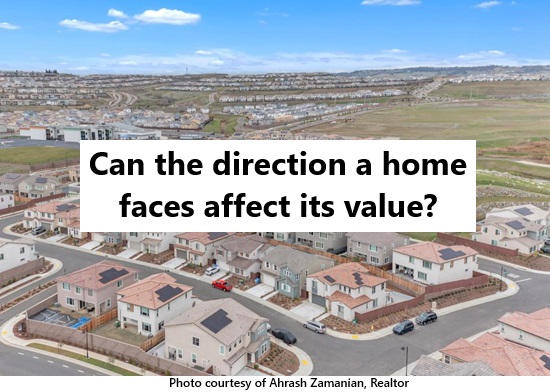Newz: Appraisal Adjustments, How Freddie and Fannie Inflated Home Prices, FHA to Adopt UAD 3.6
August 29, 2025
What’s in This Newsletter (In Order, Scroll Down)
- LIA AD Navigating Value Revisions in Appraisals
- Appraisal Adjustments: Types, Methods, and Cheat Sheet Appraisal By Kevin Hecht
- Inside Artificial Heart Inventor’s $4.8 Million Midcentury Modern Salt Lake City Utah Home
- Inflated Prices, Taxed to Death, by Jeremy Bagott
- Can the direction a home faces affect its value? By Ryan Lundquist
- The Competence to Perform an Assignment, by Timothy C. Andersen, MAI
- FHA to adopt UAD 3.6
- MBA: Mortgage applications decreased 0.5 percent from one week earlier
————————————————-
Time Adjustment Changes for Appraisers
Click here to subscribe to our FREE weekly appraiser email newsletter and get the latest appraisal news
———————————–
————————————————-
Appraisal Adjustments: Types, Methods, and Cheat Sheet Appraisal By Kevin Hecht
Excerpts:
Types of Appraisal Adjustments
Appraisal adjustments can take several forms, depending on the property characteristics being compared. Each type of adjustment addresses a different element that may influence value. Below are descriptions of common adjustment categories and their uses, followed by a “cheat sheet” chart with examples.
- Qualitative Adjustments
- Quantitative Adjustments
- Transactional Adjustments
- Market Conditions Adjustments
- Property Adjustments
- Locational Adjustments
Common Methods for Making Appraisal Adjustments
A long list, from matched paired sales to Cost Analysis
Appraiser Survey: What’s Your Go-To Method for Adjustments?
Paired sales/matched pair analysis (Most popular answer!)
“I typically cover rural areas where sales are scarce and there is not enough data for meaningful statistical analysis to be performed. Due to this, paired sales analysis is the most reasonable and defensible analysis position available.”
“I use linear regression to understand market changes and to calculate any necessary market change adjustments.”
“Depends on what item is being adjusted. If it is site or GLA, it is usually a percentage of the per acre or per square foot sales price. Other items are usually paired sales analysis or consideration for depreciated cost.”
To read more, Click Here
My comments: Comprehensive lists and interesting appraiser comments. I quit doing grid dollar adjustments many years ago. A person from our state regulator, speaking at a local appraisal meeting, said they would require support for all adjustments. I started by doing Plus and Minus grid adjustments and then went to “total property comparison” with a value. I do a qualitative analysis comparing the comps.
The only supported dollar adjustments I make are for market conditions and high dollar features such as a fantastic view of the Golden Gate Bridge from very high up a hill.

Inside Artificial Heart Inventor’s $4.8 Million Midcentury Modern Salt Lake City Utah Home
Excerpts: 4 bedrooms, 4.5 baths, 5,447 sq.ft., 0.55 acre lot, built in 1957
The mastermind behind the one-of-a-kind estate was none other than Swiss architect Eduard Dreier, who brought Bauhaus principles to the modernist movements of Utah and Nevada.
Lovingly restored and awarded the Utah Heritage Award for Restoration and Renovation, this 5, 447 sq ft architectural gem blends timeless Dreier elements-exposed steel beams, walls of glass and cantilevered roof line, granite rock walls-with warm modern luxury. The 1,110 sq ft glass-and-steel attached guest house, designed by Dreier protge Brent Groesbeck in 2016, floats above the main home, expanding living where entertaining is elevated to an art form.
To read more, Click Here
To see the listing with 43 photos and a video tour, Click Here
—————————————————–
Fannie and Freddie” Inflated Prices, Taxed to Death
by Jeremy Bagott
Excerpts: Freddie, Fannie Have Unwittingly Stoked Property Tax Firestorm. Inflated home values, engineered by Fannie and Freddie’s appraisal waivers and algorithmic lending, have distorted the market and saddled taxpayers with rising property tax burdens.
A wildfire is scorching the earth. Flashpoints are Texas, Florida, Colorado, Georgia, Illinois, Iowa, Kansas, Pennsylvania, North Dakota, New Jersey, Ohio, Nebraska and Wyoming. There are others.
Consider: The average U.S. home price in midyear 2020 was $371,100. In just two years, it jumped 41% to $525,100, as reported by the St. Louis Fed. Property values have risen almost 27% faster than inflation since 2020, according to another source. While homes are no longer affordable or accessible for many families, inflated values are an equally disturbing development for homeowners when property taxes come due. Observers often fail to see the role of federally backed mortgage giants Fannie Mae and Freddie Mac in creating the housing inflation underlying the surge in property taxes.
To read more, Click Here
My comments: Worth reading. Interesting appraiser comments, including two videos. Many more details in the article. I had never heard of this analysis. I have been reading Bagotts emailed comments for many years.
———————————————————-
Are you getting too many ad-only emails?
4 ways to get only the FREE email newsletters and NOT the ad-only emails.
1. Twitter: https://twitter.com/appraisaltoday Posted by noon Friday
2. Read on blog www.appraisaltoday.com/blog Posted by noon Friday. You can subscribe to the blog in the upper right of each blog page. NOTE: the popular ads with liability tips are below the first topic on my blog posts.
3. Email Archives: https://appraisaltoday.com/archives
(posted by noon Friday) The link is above and to the left of the big yellow email signup form. Newsletters start with “Newz.” Contains all recent emails sent.
4. Link to the 10 most recent newsletters (no ads) at www.appraisaltoday.com. Scroll down past the big yellow signup block. The newsletters have abbreviated titles, taken from their blog posts.
To read more about the 4 ways, plus information on why I take ads, etc.
———————————————-
Appraising Hoarder Homes: Key Considerations
In the July, 2025 issue of Appraisal Today.
Excerpts:
Let’s discuss the key issues I look for when appraising a hoarder home.
1. Limited Access = Limited Observations
One of the first hurdles is simply trying to inspect the interior. When clutter
blocks off entire rooms or covers walls, floors, and ceilings, it makes it
tough-sometimes impossible-to get a clear picture of the home’s condition.
I’ve been in homes where I couldn’t access:
- Bedrooms and bathrooms
- The basement or attic
- Mechanical systems like the furnace or electrical panel
When that happens, I have to make it clear in the report that I wasn’t able to
inspect certain areas. Most lenders require that the appraiser view every room. If the appraisal is not for lending purposes, then specific assumptions (Extraordinary Assumptions) must be made regarding the condition of the unseen room… In my experience, when appraising these types of properties, it is common to make these types of assumptions, making it difficult for lending as many lenders will not accept an appraisal with an extraordinary assumption.
2. What You Can’t See Might Hurt You
A major issue with hoarder homes is what’s hiding beneath the clutter. Just
because I can’t see damage doesn’t mean it’s not there. As I mentioned in my
opening comments, I have crawled over several feet of debris throughout the
interior of a home. You just never know what’s beneath the debris
Editor’s comments: Most appraisers are asked to appraise hoarder homes. This is the first appraisal article I have read about this topic. I have appraised hoarder homes many times in my 50 years of appraising. I figured out what to do, but I would have liked having this article when I first started appraising them.
To read the full article with more tips on appraising hoarder homes, plus 3+ years of previous issues, subscribe to the paid Appraisal Today at www.appraisaltoday.com/order
Not sure if you want to subscribe?
Sign up for monthly auto renewal for $8.25!
Cancel at any time for any reason! You will receive a prorated refund.
$8.25 per month, $24.75 per quarter, and $89 per year (Best Buy)
or $99 per year or $169 for two years
Subscribers get FREE: past 18+ months of past newsletters
What’s the difference between the Appraisal Today free Weekly email newsletter and the paid Monthly newsletter? Click here for more info. Subscribe to Monthly Newsletter
——————————————————————
If you are a paid subscriber and did not receive the August 2025 issue emailed on Friday, August 1, 2025 please email info@appraisaltoday.com, and we will send it to you. You can also hit the reply button. Be sure to include a comment requesting it.
———————————————-
Can the direction a home faces affect its value?
By Ryan Lundquist
NOTE: To read the direction comments, scroll down to just above and below the photo above.
Excerpts: We’re seeing increased awareness around Vastu or Feng Shui principles too. These aren’t niche preferences anymore — they’re influencing how homes are priced and how quickly they sell. Understanding those subtleties helps sellers position their home better and buyers find what truly fits.
Ahrash (real estate agent): One of the most important — and often overlooked — buyer preferences in Folsom Ranch is home orientation, especially when it comes to south-facing homes. Whether or not a buyer personally cares about direction, the market clearly does, and the data shows it.
South-facing homes are often the ones sitting longer, and they’re frequently what builders offer as quick move-ins with large incentives. They tend to be more common in builder inventory, which makes them less unique. As a result, even if orientation isn’t a factor for a particular buyer today, it will impact resale value and days on market down the line.
In contrast, east-facing homes — along with homes that offer better light, energy efficiency, or alignment with cultural preferences — tend to sell faster and at stronger price points.
It’s so important to understand the motivation of buyers in particular locations and price points. So, if facing a certain direction can matter, let’s keep that on the radar as we choose comps and consider value. But remember, buyer preferences are a moving target that can change over time, so it’s key to not impose ideas on the market. Also, this might not really be much of a thing in some area at all.
The goal is to weigh the comps and let them speak to us. Lastly, when it comes to new construction, it’s important to watch the brand-new market and adjacent existing market. I think one of the most challenging homes to sell right now is the almost new home that may struggle to compete with builders in terms of both incentives and price.
Two of the appraiser comments:
I cover the Finger Lakes in upstate NY. The folks on the west sides of the lakes say the west is superior because they get to see the sun rise. The folks on the east sides believe the east is superior because they get the sunsets.
In Denver, CO the houses that get the sun on the driveway are the preferred houses = mostly facing north. Light Snow gets sublimated!
To read more, Click Here
My comments: I have never read anything about this topic that many appraisers see. Interesting appraiser comments from their experiences with home direction.
In my market Feng Shui principles can sometimes be important. One time the address on the comp was different than the MLS and public records. I called the city planning department. The owners had successfully petitioned to get their address changed – Feng Shui.
In another area, with high summer temperatures, buyers did not like west facing due to the sun making the home’s interior hot. How did I know? I looked at the MLS comments which almost always said if the house faced east or west. The homes were in a recently built subdivision, so it was not difficult to make a dollar adjustment.
What is important is to be sure if it is just a preference for some buyers, or can affect the market and value of a home.
—————————————————
The Competence to Perform an Assignment
by Timothy C. Andersen, MAI
Question: I recently bought a multivariable regression analysis (MVRA) app for my computer. I didn’t have much data because my subject was a rural property, but I entered the data into the MVRA as the instructions said. The app gave me a value that was 15 percent higher than the purchase and sale agreement. I thought this meant the buyer got a good deal. I turned in the report on time with a properly signed certificate.
Now, the seller, buyer, broker, AMC, and lender are threatening to sue me and might report me to the state because they say my value was wrong. I don’t understand! If anything is wrong, it’s the app. How do I sue the app company?
Response: There are too many issues to cover all of them, so let’s focus on one—using the app. We’ll also look at what Uniform Standards of Professional Appraisal Practice (USPAP) thinks about this. Only the appraiser (not the app!) is responsible for the appraisal (Standard 1) and the appraisal report (Standard 2)…
My comments: Interesting short article by Tim, The USPAP Expert! I had always wondered about using this method. Appraisers Be Careful! I started appraising 50 years ago. Always something New! That is the primary reason I love appraising. I gave up lender appraising in 2005, Have never worked for an AMC. I liked my lender clients. Did only non-lender appraisals after 2005.
To read more, Click Here
——————————————————-
FHA to adopt UAD 3.6
FHA INFO 2025-42
August 27, 2025
Today, the Federal Housing Administration (FHA) is pleased to announce its adoption of the modernized Uniform Appraisal Dataset (UAD) 3.6 beginning early Spring 2026. Following collaboration with the Government Sponsored Enterprises (GSEs), and the Department of Housing and Urban Development’s (HUD) investment in the FHA Catalyst platform during the first Trump Administration, the implementation of this industry-wide initiative will preserve FHA’s alignment with the industry and strengthen its collateral risk management capabilities.
- In Spring 2026, FHA systems will be updated and ready to support optional deliveries of UAD 3.6 for FHA cases.
- A timeline of the transition plan, updated policies, and technology specifications will be announced later this year.
- The transition period will allow for the delivery of both the current UAD 2.6 and the new 3.6 format.
- FHA is committed to providing stakeholders with reasonable time to develop, test, and prepare their technology solutions before mandatory adoption, recognizing that a longer timeframe is essential to accommodate required technology updates.
This FHA document was not available as of two days ago when I wrote this newsletter. It will be posted on the FHA Info Page. To read Click Here This link was not working yesterday, but the info above has must of the information from the letter.
My comments: Very good idea as buyers can switch from conventional to FHA loans. When, and if, VA and USDA Rural Development will use UAD 3.6 is uncertain. FHA is adopting UAD 3.6 (see end of this email)
————————————————–
HOW TO USE THE NUMBERS BELOW. Appraisals are ordered after the loan application. These numbers tell you the future for the next few weeks. For more information on how they are compiled, Click Here.
Note: I publish a graph of this data every month in my paid monthly newsletter, Appraisal Today. For more information or get a FREE sample go to www.appraisaltoday.com/order Or call 510-865-8041, MTW, 7 AM to noon, Pacific time.
My comments: Rates are going up and down. We are all waiting for rates to drop in 2025.
Mortgage applications decreased 0.5 percent from one week earlier
WASHINGTON, D.C. (August 27, 2025) — Mortgage applications decreased 0.5 percent from one week earlier, according to data from the Mortgage Bankers Association’s (MBA) Weekly Mortgage Applications Survey for the week ending August 22, 2025.
The Market Composite Index, a measure of mortgage loan application volume, decreased 0.5 percent on a seasonally adjusted basis from one week earlier. On an unadjusted basis, the Index decreased 2 percent compared with the previous week. The Refinance Index decreased 4 percent from the previous week and was 19 percent higher than the same week one year ago. The seasonally adjusted Purchase Index increased 2 percent from one week earlier. The unadjusted Purchase Index decreased 0.1 percent compared with the previous week and was 25 percent higher than the same week one year ago.
“Mortgage rates inched higher for the second straight week, with the 30-year fixed-rate up to 6.69 percent. While this was not a significant increase, it was enough to cause a pullback in refinance applications,” said Joel Kan, MBA’s Vice President and Deputy Chief Economist. “Purchase applications had their strongest week in over a month, up 2 percent, and the average loan size increased to its highest level in two months at $433,400. Prospective buyers appear to be less sensitive to rates at these levels and are more active, bolstered by more inventory and cooling home-price growth in many parts of the country.”
The refinance share of mortgage activity decreased to 45.3 percent of total applications from 46.1 percent the previous week. The adjustable-rate mortgage (ARM) share of activity decreased to 8.4 percent of total applications.
The FHA share of total applications remained unchanged at 19.1 percent from the week prior. The VA share of total applications decreased to 13.3 percent from 13.4 percent the week prior. The USDA share of total applications decreased to 0.5 percent from 0.6 percent the week prior.
The average contract interest rate for 30-year fixed-rate mortgages with conforming loan balances ($806,500 or less) increased to 6.69 percent from 6.68 percent, with points remaining unchanged at 0.60 (including the origination fee) for 80 percent loan-to-value ratio (LTV) loans. The effective rate remained unchanged
The average contract interest rate for 30-year fixed-rate mortgages with jumbo loan balances (greater than $806,500) increased to 6.67 percent from 6.64 percent, with points decreasing to 0.44 from 0.60 (including the origination fee) for 80 percent LTV loans. The effective rate decreased from last week.
The average contract interest rate for 30-year fixed-rate mortgages backed by the FHA decreased to 6.35 percent from 6.39 percent, with points increasing to 0.80 from 0.66 (including the origination fee) for 80 percent LTV loans. The effective rate decreased from last week.
The average contract interest rate for 15-year fixed-rate mortgages increased to 6.03 percent from 5.96 percent, with points increasing to 0.77 from 0.70 (including the origination fee) for 80 percent LTV loans. The effective rate increased from last week.
The average contract interest rate for 5/1 ARMs decreased to 5.94 percent from 6.01 percent, with points increasing to 0.68 from 0.63 (including the origination fee) for 80 percent LTV loans. The effective rate decreased from last week.
The survey covers U.S. closed-end residential mortgage applications originated through retail and consumer direct channels. The survey has been conducted weekly since 1990. Respondents include mortgage bankers, commercial banks, thrifts, and credit unions. Base period and value for all indexes is March 16, 1990=100.
————————————————-
 Ann O’Rourke, MAI, SRA, MBA
Ann O’Rourke, MAI, SRA, MBA
Appraiser and Publisher Appraisal Today
1826 Clement Ave. Suite 203 Alameda, CA 94501
Phone: 510-865-8041
Email: ann@appraisaltoday.com
Online: www.appraisaltoday.com



We want to know what you think!! Please leave a comment.